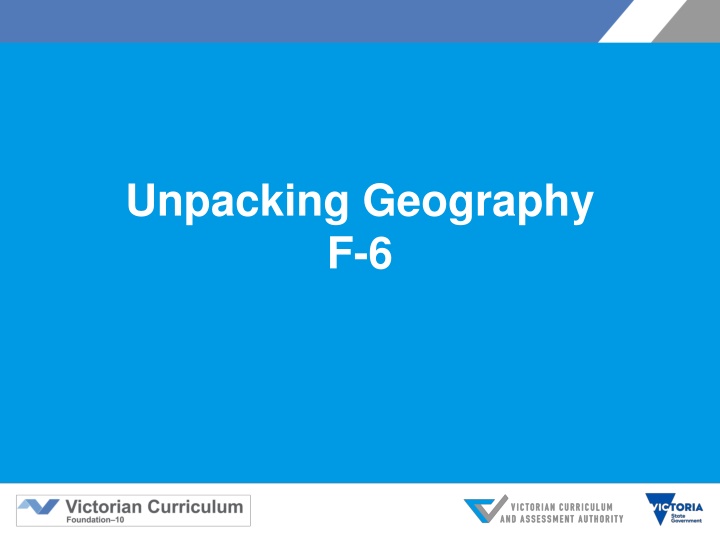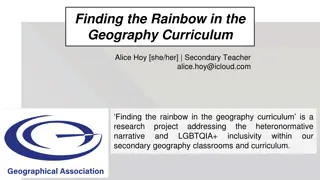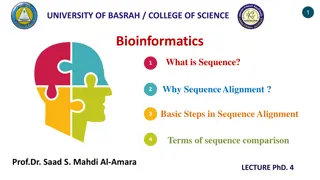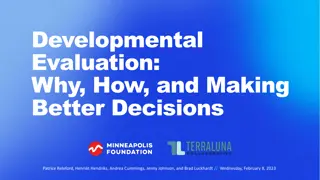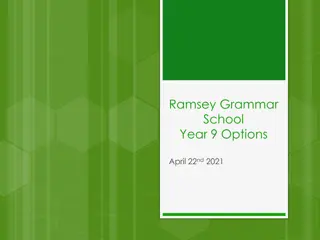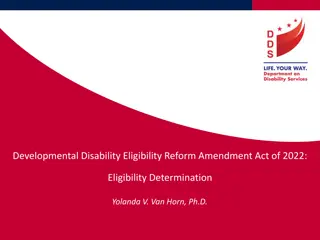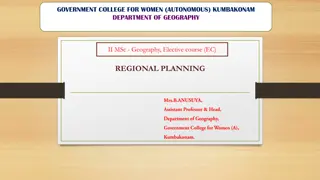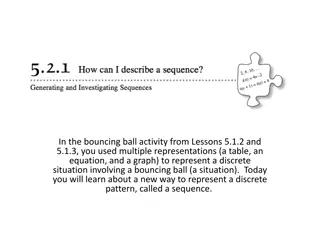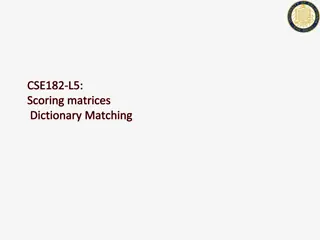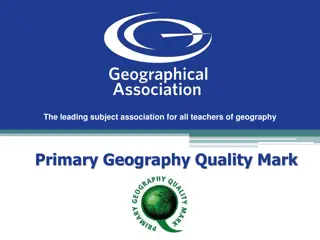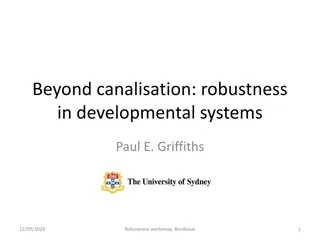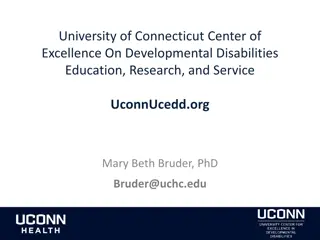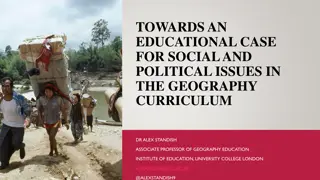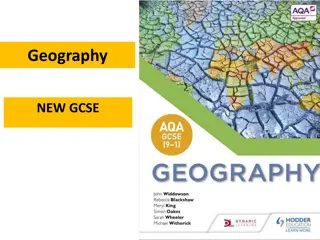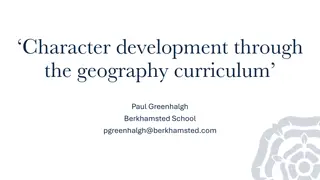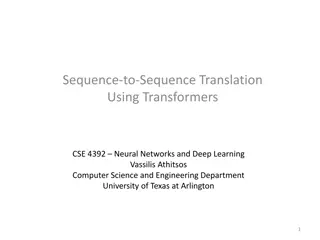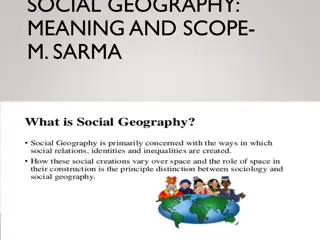Geography Curriculum Developmental Sequence
This session introduces the structure, key concepts, and development sequence of the Geography curriculum. Significant revisions aim to strengthen conceptual thinking, knowledge, and skills for students. The curriculum emphasizes geographical concepts and skills to enable students to become competent, critical, and creative users of geographical methods and to contribute to a sustainable and just world.
Download Presentation

Please find below an Image/Link to download the presentation.
The content on the website is provided AS IS for your information and personal use only. It may not be sold, licensed, or shared on other websites without obtaining consent from the author.If you encounter any issues during the download, it is possible that the publisher has removed the file from their server.
You are allowed to download the files provided on this website for personal or commercial use, subject to the condition that they are used lawfully. All files are the property of their respective owners.
The content on the website is provided AS IS for your information and personal use only. It may not be sold, licensed, or shared on other websites without obtaining consent from the author.
E N D
Presentation Transcript
Objectives This session will introduce you to: the structure of the curriculum its key concepts developmental sequence of the curriculum
Key messages No longer general Humanities from F 4 Specific Geography curriculum from F 10 Revised structure Development of conceptual thinking strengthened Significant revisions to knowledge and skills Revisions to achievement standards
Aims The Geography curriculum aims to ensure that students develop: a sense of wonder, curiosity and respect for places, people, cultures and environments throughout the world a deep geographical knowledge of their own locality, Australia, the Asia region and the world the ability to think geographically, using geographical concepts the capacity to be competent, critical and creative users of geographical methods and skills the capacity to be informed, responsible and active citizens who can contribute to the development of a world that is environmentally and economically sustainable, and socially just.
Structure Structure: Strands and sub-strands Achievement standards The first achievement standard at Foundation Level 2 and then at Levels 4, 6, 8 and 10. A curriculum for students with disabilities is provided in this learning area.
Points to note: Levels A-D is a curriculum for students with disabilities Content descriptions (CDs) are banded, that is, levels F-2 share common content descriptions, followed by two level bands: Levels 3-4, 5-6, 7-8 and 9-10. The curriculum describes a continuum of learning Content descriptions are mandated while elaborations are not mandated, for example: Suggestions on how a CD could be approached
Key messages Geographical concepts and skills Strengthens the progression of geographical skills essential to working with data and information and conceptual thinking necessary to work with geographical knowledge content descriptions Seven concepts underpin the whole curriculum: Place Environment Space Sustainability Interconnection Change Scale
Geographical concepts The Place, space and interconnection sub-strand identifies progression in conceptual thinking, with emphasis on the concepts of place, space, interconnection. The concepts of scale and change are integrated into this sub-strand. Environment and sustainability are represented in Geographical knowledge strand. More information about the concepts can be found in Learning in Geography (from the Introduction drop down menu on the Victorian Geography curriculum page)
Progress in conceptual thinking is identified across the Place, Space and Interconnection sub-strand, and students work towards this through engagement with the whole curriculum. This is illustrated in the elaborations for the Place, space and interconnection sub-strand, which draw on other areas of the curriculum, for example:
Example of progression place, space and interconnection sub-strand 5-6 Identify and describe locations and describe and explain spatial distributions and patterns 9-10 Identify, analyse and explain significant spatial distributions and patterns and identify and evaluate their implications over time and at different scales F-2 Describe and explain where places and activities are located 3-4 7-8 Identify, analyse and explain spatial distributions and patterns and identify and explain their implications Identify and describe locations and spatial distributions and patterns
Example: (3-4): Main climates of the world and similarities and differences between the climates of different places Identify and describe locations and spatial distributions and patterns (3-4) Explain this climate in terms of temperature and rainfall Identify and describe locations and describe and explain spatial distributions and patterns (5-6) What type of climate does Melbourne have? Where can this climate be found across Australia? Where can this climate be found across the world? Is there a pattern? Describe and explain where places and activities are located (F-2)
Data and information sub-strand Overview describes progression in skills for: Collecting and recording data and information Representing data and information Interpreting, analysing and evaluating data and information
Example of progression data and information sub-strand 5-6 Interpret maps and other geographical data and information using digital and spatial technologies 9-10 Analyse and evaluate data, maps and other geographical information using digital and spatial technologies and Geographical Information Systems F-2 Interpret data and information to draw conclusions 3-4 7-8 Analyse maps and other geographical data and information using digital and spatial technologies Interpret maps and other geographical data and information to develop identifications, descriptions, explanations and conclusions
Data and information sub-strand Mandates the use of digital and spatial technologies from Levels 5-6 This sub-strand could be used as a basis for fieldwork/inquiry, which could be supplemented with, for example: content descriptions from other curricula. For example content on Questioning and possibilities sub-strand in Critical and creative thinking capability to help teach how to construct a question for investigation or survey questions. Content within Geographical knowledge, for example in asking students to respond to a geographical challenge, for example: CD is used to inform an aspect of an inquiry
Geographical knowledge strand F-6: Key features Students begin by learning that places have particular features and that people are connected within the same place or to different places. They go on to learn that places are both similar and different and then consider why this may be so. They gradually learn to recognise and explain the complex interconnections within and between places This progression is integrated with learning essential Geographical knowledge and skills A mental map of the world is gradually developed from F-2 in a way that supports the development of knowledge within a given band
Key questions F-2 3-4 What are places like? How and why are people connected to their place and other places? What makes a place special? How can we care for places? 5-6 How and why are places similar and different? What would it be like to live in a neighbouring country? How does the environment support the lives of people and other living things? How can people use places and environments more sustainably? How do places, people and cultures differ across the world? How do people s connections to places affect their perception of them? How do people and environments influence one another? How can the impact of bushfires or floods on people and places be reduced?
Achievement standards The achievement standards for Geography show development in conceptual understanding and skills and a gradually developing mental map of the world. They are aligned to Geographical concepts and skills and Geographical knowledge strands Note that in levels F-6 development of mental map of the world is explicit
Example By the end of Level 4 students identify and describe spatial characteristics By the end of Level 6 students describe and explain spatial characteristics By the end of Level 2 students describe and explain location The southern edge of Australia and the eastern edge to just north of Brisbane has a temperate climate. This follows a pattern of temperate climates in the south east of most continents. A place with a similar climate to Melbourne is Paris Melbourne has a temperate climate because of its combination of rainfall and temperature over a long period of time, showing warm summers and cold winters Melbourne is in the south east of Australia. Melbourne is located in a temperate climate area
Example - Working with the Achievement standards Main climates Main climates of the world and the similarities and differences between the climates of different places Content from Geographical concepts and skills By the end of Level 4, students identify and describe spatial characteristics By the end of Level 6 students describe and explain spatial characteristics By the end of Level 2 students describe and explain location
Contact and resources Curriculum Planning, Assessment and Reporting resources http://www.vcaa.vic.edu.au/Pages/foundation10/viccurriculum/curriculumplan ning.aspx Contact Monica Bini VCAA Curriculum Manager, Humanities and Social Sciences Email: bini.monica.m@edumail.vic.gov.au Phone: 9032 1693
